Color Psychology Facts and Statistics
Welcome to our roundup of color psychology facts.
Color is a design element that creators often overlook, but it can have a big impact on the way people react and respond to your content.
Color psychology is the study of how color affects people’s emotions. It can help inform designers, marketers, and brands about which colors are the best to use in certain designs.
In this article, we’ll provide some important color psychology facts and statistics relating to popularity, color associations, and more that can help you get to grips with using color in your content.
Let’s get started with some of our top color psychology facts.
Color psychology facts and statistics (top picks)
- 60% of people accept or reject new products based on color
- 62%-90% of initial impressions are based on color alone
- The most popular color overall is blue
- The least popular color overall is orange
- Blue is mostly associated with trust and security
- Blue is also the most popular website color among consumers
- The least popular colors for websites are yellow and orange
What is color psychology?
Color psychology is the study of how different colors can affect humans. The way people perceive color is affected by a number of different factors including culture, science, age, gender, and more.
Color psychology assesses colors’ impact on people’s moods, emotions, and receptiveness to new ideas, products, and more.
Whether you’re a business owner, web designer, or marketer, it’s a good idea to know more about the impact the colors you use will have on the people who are viewing your content and products.
How important is color psychology in business?
Selecting the right colors for your business branding, products and advertisements are more important than you might think. For example, 80% of people think that color increases brand recognition and the importance of color doesn’t end there.
Here are some interesting color psychology facts about how color can impact businesses.
Color is the key factor in whether or not customers accept or reject a product
Color plays a huge part in people’s receptiveness to new products. According to Skilled, color alone is the deciding factor in whether to accept or reject a product for about 60% of people.
Almost 85% of people say that color is the main reason that they buy a certain product
According to WebFX, a study showed that 84.7% of people said that the primary reason they purchased a particular product was because of the color. This shows just how much impact choosing the right color can have on your product sales.
Up to 90% of initial impressions are based on color
According to WebFX, it takes around 90 seconds for a person to form a judgment about a product or a new environment. Based on the results of their study, it’s thought that 62% – 90% of that initial impression is based on colors.
Color ads are viewed almost 50% more than black-and-white ads
Color is super important when it comes to advertising too. According to WebFX, ads with color are viewed 42% more than their black and white counterparts.
Color popularity statistics
Everybody has a favorite color, however, it turns out that there are trends amongst different demographic groups related to what colors they do and don’t like. Here are some useful facts and stats about color popularity.
What is the most popular color worldwide?
Overall, blue is the most popular color. In a study conducted by Joe Hallock, 42% of people said that their favorite color was blue, making it the most popular choice by a significant margin. The study found that the next most popular color was green, with 14% of those surveyed choosing this color.
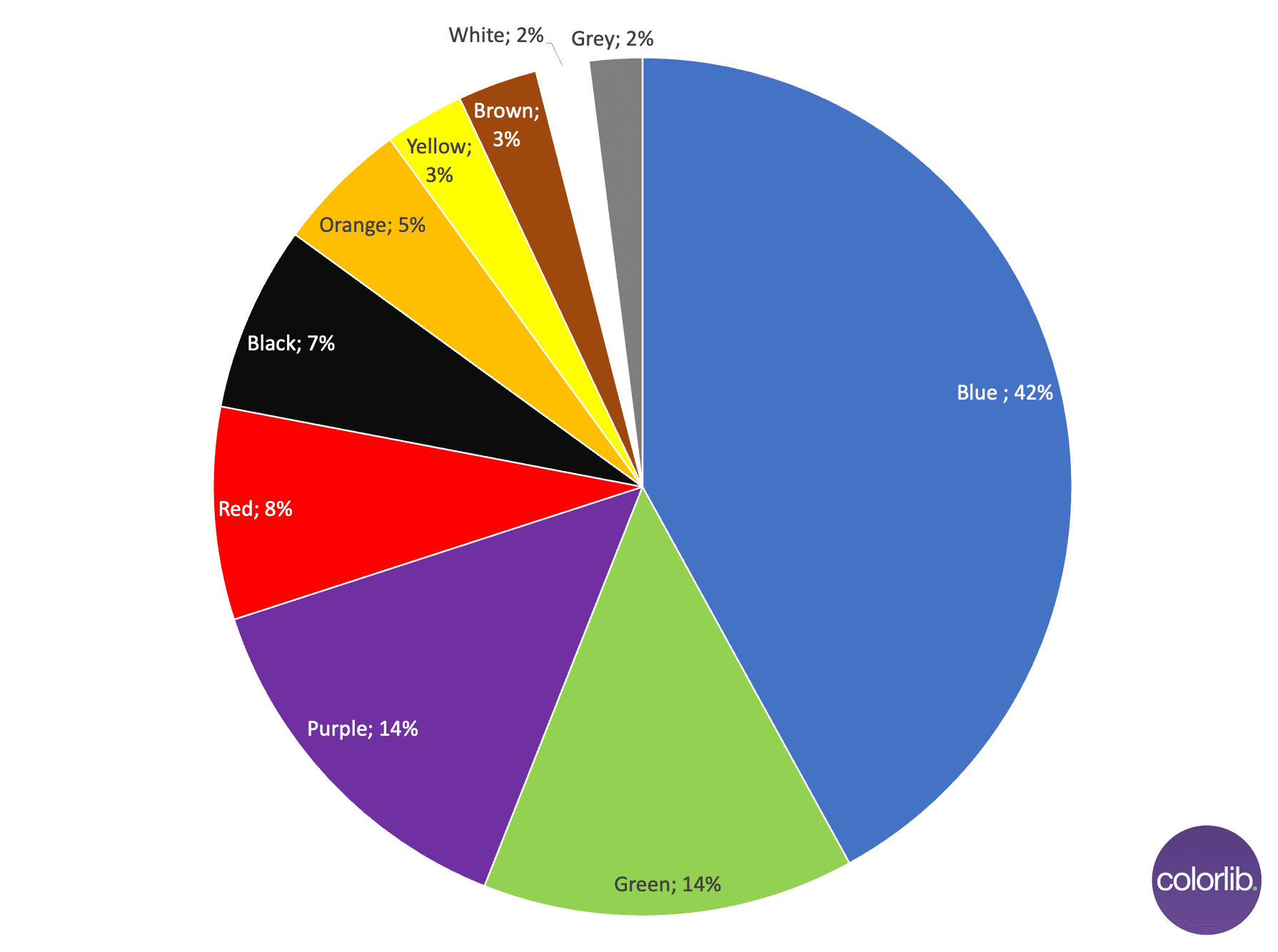
What color is the least popular?
Overall, the least popular color was orange, with 30% of those surveyed voting for it as their least favorite. Other unpopular colors included brown (23%) and purple (13%).

What are the most popular colors amongst women?
A survey including only women also found that the most popular color was blue. 35% of women surveyed voted blue, but a considerable number also voted for purple (23%). The least popular colors amongst women were orange (33%) and brown (20%).

What are the most popular colors amongst men?
According to the study, men overwhelmingly favor blue, with 57% of voters choosing this as their favorite color. The least popular colors amongst men were brown (24%), purple, and orange (22%).

Sources: Joe Hallock1
What color is most popular amongst young people?
Across age groups, the most popular color is blue. However, young people aged 1-35 also showed a significant preference for brighter colors like green, purple, red, and orange.
However, older generations such as those 70+ selected only blue and white as their favorite colors.

What are the least popular colors amongst young people?
Amongst those aged 1-24, brown was found to be the least popular color overall. For those ages 35-50, orange was the least popular color. Older people 70+ also disliked orange, as well as purple, and blue.
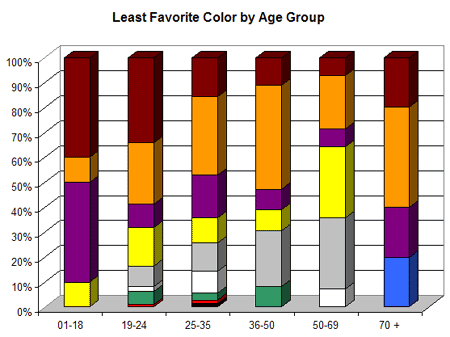
Sources: Joe Hallock
Color psychology associations
The human brain naturally associates certain colors with certain emotions and ideas.
Whether you’re designing a website, choosing colors for a new business, or planning a party, it’s useful to know what sort of ideas and emotions each color is associated with.
Below is a list of popular colors and their most common associations.
Blue
According to a study conducted by Joe Hallock, blue is most commonly associated with trust and security. When asked which color connotes trust, 34% of those surveyed responded blue.
Similarly, 28% of people voted blue when they were asked which color they associated with security. The study also found that people associate blue with reliability and dependability.
Red
Red is overwhelmingly associated with speed. 76% of people voted red when asked which color they most associated with speed.
Red has also been linked to courage and bravery, with 28% of people associating red with these emotions.
Yellow
Yellow is often associated with fun and happiness, with 26% of people saying they associate yellow most with this emotion.
However, yellow can also have negative connotations, with some people linking muted shades of yellow to nausea and sickness.
Black
Black is most commonly associated with high-quality products and high technology. According to a Joe Hallock study, 26% of people associate black with high tech, and 43% associate it with high quality.
Similarly, the color black is linked to fear and terror, according to 38% of those surveyed.
Purple
Purple is strongly associated with bravery, with 29% of people saying that they linked purple with courage and bravery.
It’s also seen as one of the most fun colors, with 17% of those surveyed saying they associate this color with feeling fun and happy.
Green
Green is often associated with good luck or financial wealth. According to the Joe Hallock color assignment study, many people also link the color green with security and trust.
Silver/Grey
Like black, silver and grey tones are often associated with high technology.
Around 23% of people said that they associated silver and grey with high technology, and a good portion also linked the colors to high quality.
Gold
As you can imagine, gold is most commonly associated with luxury and expensive goods according to Colorcom. It also has links to high quality.
Sources: Colorcom1, Joe Hallock2
Color psychology in web design
According to Top Design Firms, 39% of people believe that colors are the most valued element on a website, so it’s important to nail it when it comes to the colors of your website.

Here are some statistics that will teach you more about color psychology and web design.
What is the best color for a website?
For website visitors, the most popular color of a website is blue. According to Top Design Firms, around half (46%) said they preferred blue. Other popular colors include green with 30% of people preferring this color, and 22% said they prefer red.
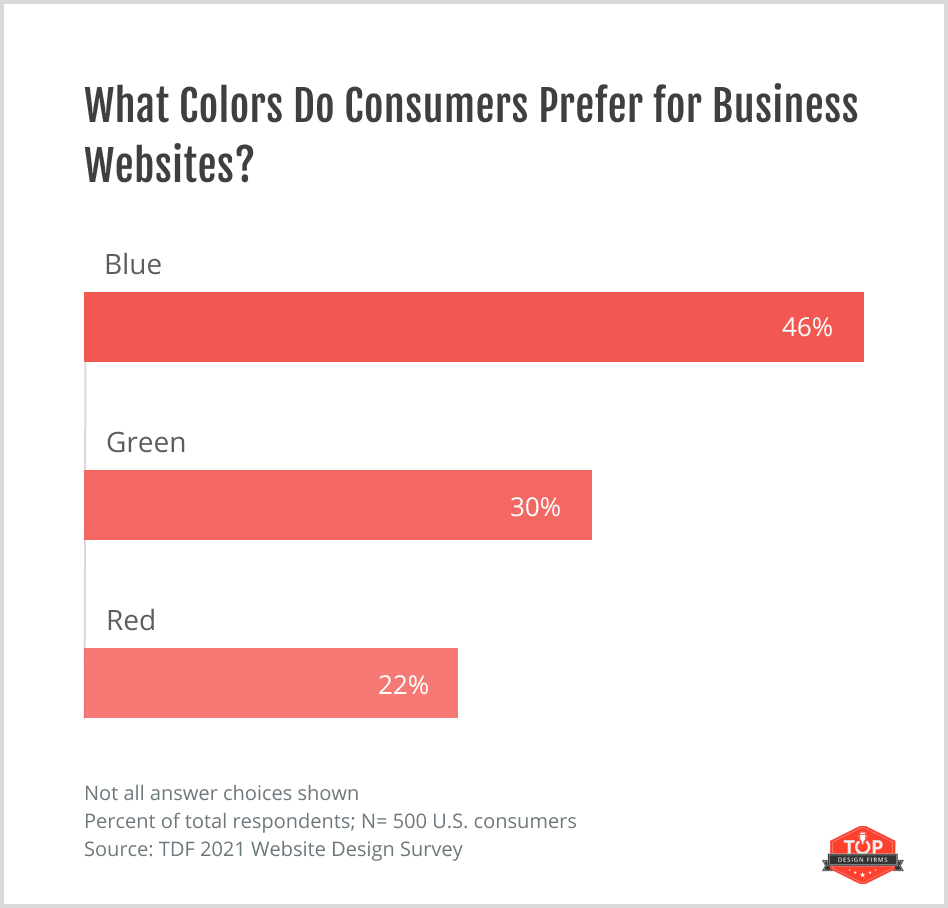
What is the least popular color for a website?
In line with the statistics we listed about color popularity above, yellow and orange are also the least popular colors for web design. 23% of people said businesses shouldn’t use yellow in their web design, and 22% of people said the same about orange.
What is the best color for CTA and buy buttons?
As we found out above, all colors have different connotations, so the best colors for buy and CTA buttons depend on what emotional effect you wish to have on your customers.
According to ConvertKit, yellow buy buttons are fun, youthful, and appealing to window shoppers. Whereas orange buy buttons are more aggressive and therefore are best for hard-sells. Here are some other connotations of buy and CTA button colors.
- Green – Easy for the eyes to process and helps customers feel relaxed
- Red – Urgent and energetic making it a good choice for ‘Buy Now’ buttons and sales
- Blue – Evokes trust and security making a good choice for banks.
- Pink – Associated with femininity making it suitable for marketing products targeted at women
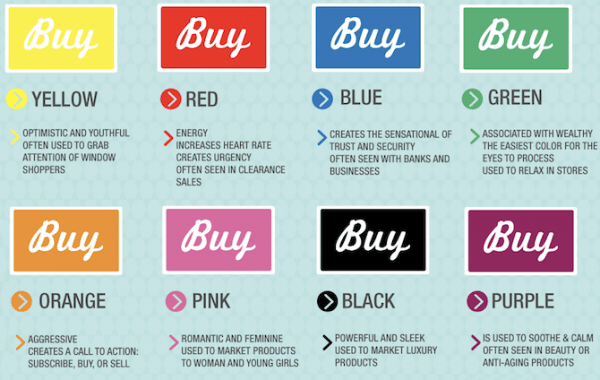
The color of buy buttons is quite important, according to some case studies. A study carried out by the company Maxymiser helped them increase CTR by up to 11%, merely by changing and testing different buy button colors.
Sources: Top Design Firms1, Top Design Firms2, ConvertKit, Usersnap
The importance of white space in web design
When designing your website and choosing a color scheme it can be tempting to try and fill your page with as much color, images, and information as possible. However, studies have shown that having some white space on your web pages is not actually a bad thing.
According to Top Design Firms, only 8% of people actually notice white space and leaving some can help to enhance your designs and make them more digestible for your visitors. Gaps between elements like text boxes, buttons, and images can make it easier for your viewers to focus on and navigate your website.
Final thoughts
So there you have it – all the color psychology facts you need to inform your designs. As you can see, color has a huge impact on people’s emotions and reactions, so it’s important to know your stuff and make the right color choices when it comes to your business branding and online content. If you’d like to know more about the use of color in web design, check out some of our other articles, including Website Color Statistics and Most Colorful WordPress Themes.


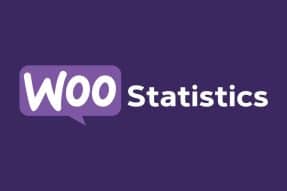

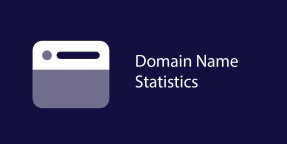


This Post Has 0 Comments